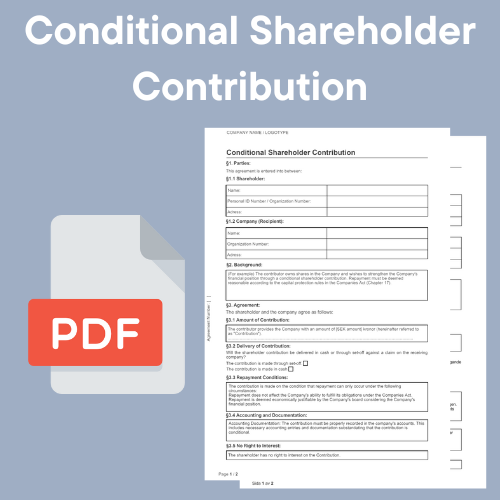Different types of Shareholder Contributions
Share
Different types of Shareholder Contributions
Table of Contents
- Introduction
- Conditional shareholder contributions
- Unconditional shareholder contributions
- Tax law aspects
- Summary
- Reference to legislation and practice
Introduction
Shareholder contributions are a form of capital contribution that shareholders can give to a company to strengthen its financial situation. There are mainly two types of shareholder contributions: conditional and unconditional. These additions have different legal and financial consequences both for the company and for the shareholders. In this article, we go through what these types mean, their legal framework and practice examples from Swedish law.
Conditional shareholder contributions
A conditional shareholder contribution means that the contributor has the right to get his contribution back under certain conditions. The repayment takes place when the company has sufficient distributable profits, and it must be decided at a general meeting. This contribution is treated in practice as a loan from the shareholder to the company.
Legal aspects
According to the Companies Act (ABL) chapters 17 and 18, the repayment of conditional shareholder contributions is regulated. The repayment is seen as a profit distribution and must therefore be accommodated within the company's distributable funds according to the most recently determined balance sheet. In addition, the repayment must comply with the precautionary rule in ABL 17:3. This rule means that the dividend must be reasonable with regard to the company's need for consolidation, liquidity and position in general.
Practical example
A common scenario is that shareholders provide a conditional contribution during financially difficult times, for example during a recession or a crisis period such as the pandemic. When the company starts generating profit again, the general meeting decides on repayment of the contribution as sufficient profit funds become available. This can take place in instalments, which means that part of the contribution is repaid every year, depending on the company's financial development.
Unconditional shareholder contributions
Unconditional shareholder contributions mean that the contribution is given without the right to repayment. This can be compared to a gift from the shareholder to the company and strengthens the company's capital base without creating any future liabilities.
Legal aspects
Since an unconditional shareholder contribution does not give the right to repayment, there are no specific rules in the Companies Act governing repayment. This addition is not treated as a liability in the company's balance sheet and thus has no direct impact on the company's liquidity or distributable funds.
Practical example
Unconditional shareholder contributions are often used to strengthen the company's financial position before major investments or expansions. Since there is no expectation of repayment, the company can use these funds freely without having to take into account future payments to shareholders.
Tax law aspects
In terms of tax law, conditional shareholder contributions are treated as loans, which means that the repayment is not taxed as a dividend. This can have significant tax advantages for both the company and the shareholder. For unconditional shareholder contributions, which are considered gifts, there are no direct tax implications at the time of contribution, but any profits generated by the contributed funds may be taxed in the ordinary way.
Summary
Understanding the differences between conditional and unconditional shareholder contributions is crucial to being able to make informed decisions about capital contributions in a limited company. Both forms have their advantages and should be used strategically depending on the company's needs and the shareholders' expectations.
Reference to legislation and practice
- The Swedish Companies Act (ABL) chapters 17 and 18 regulate value transfers and profit distribution, including repayment of conditional shareholder contributions.
- The precautionary rule in ABL 17:3 ensures that repayments and dividends are reasonable with regard to the company's needs and position.
- Practical examples from legal cases and advisory services such as Legalbuddy show how these contributions can be practically handled and repaid under various conditions.
By using these additions in a well-thought-out way, companies can strengthen their financial position and ensure long-term sustainability, while protecting the shareholders' interests.



